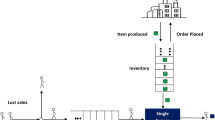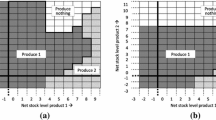Abstract
The system investigated consists of a stochastic periodic stream of raw material, a continuous processing operation with controllable deterministic service rates, and a storage facility. The arrival stream is periodically interrupted and divided into alternating on-off intervals of fixed length. The processing facility is allowed to operate during the off-interval. Superimposed on this system is a cost structure composed of processing and holding costs. Such operations may be found in manufacturing as well as service systems (for example, dry cleaners, machine shops, repair and maintenance shops, printers, information processing centers, etc). A service rate control rule that minimizes the infinite-horizon discounted expected total cost is found. Existence and uniqueness of long-term optimal cost and policy functions is shown. Since the optimal policy cannot be expressed explicitly, an approximate solution was obtained. An error bound on the optimal cost associated with this solution is exhibited. The approximate solution is characterized by a service rate control rule that is a linear function of the level of inventory at the start of each on-interval and a piecewise linear function of inventory at the start of each off-interval. The optimal discounted expected total cost is quadratic in the inventory level at the start of each interval. Computational results indicate relative cost errors in the order of 2–3 percent.
Similar content being viewed by others
References
Thatcher, R. M.,Optimal Single-Channel Service Policies for Stochastic Arrivals, Report ORC-68-16, Operations Research Center, University of California, Berkeley, California, 1968.
Bellman, R. E., andDreyfus, S. E.,Applied Dynamic Programming, Princeton University Press, Princeton, New Jersey, 1962.
Denardo, E. V.,Contraction Mappings in the Theory Underlying Dynamic Programming, SIAM Review, Vol. 9, pp. 165–177, 1967.
Blackwell, D.,Discounted Dynamic Programming, Annals of Mathematical Statistics, Vol. 36, pp. 226–235, 1965.
Stern, H. I.,Optimal Service Policies for Solid Waste Treatment Facilities, Report ORC-69-3, Operations Research Center, University of California, Berkeley, California, 1969.
Glassey, C. R. Verbal Communication.
Bensoussan, A., andTapiero, E. S.,Impulsive Control in Management Prospects and Applications, Journal of Optimization Theory and Applications, Vol. 37, pp. 419–442, 1982.
Author information
Authors and Affiliations
Additional information
Communicated by M. D. Intriligator
This research was performed at the Sanitary Engineering Research Laboratory and Operations Research Center of the University of California, Berkeley. It was made possible by US Public Health Research Grant UI-00547 from the Environmental Control Administration-Bureau of Solid Waste Management and by National Science Foundation Grant GK-1684.
The author thanks Professor C. R. Glassey for not only suggesting this research, but for his constant encouragement and suggestions throughout its duration. He also thanks Professors W. S. Jewell and P. H. McGauhey whose comments on the draft were very helpful.
Rights and permissions
About this article
Cite this article
Stern, H.I. Optimal control of a facility with periodic interrupted demand. J Optim Theory Appl 73, 577–599 (1992). https://doi.org/10.1007/BF00940057
Issue Date:
DOI: https://doi.org/10.1007/BF00940057




